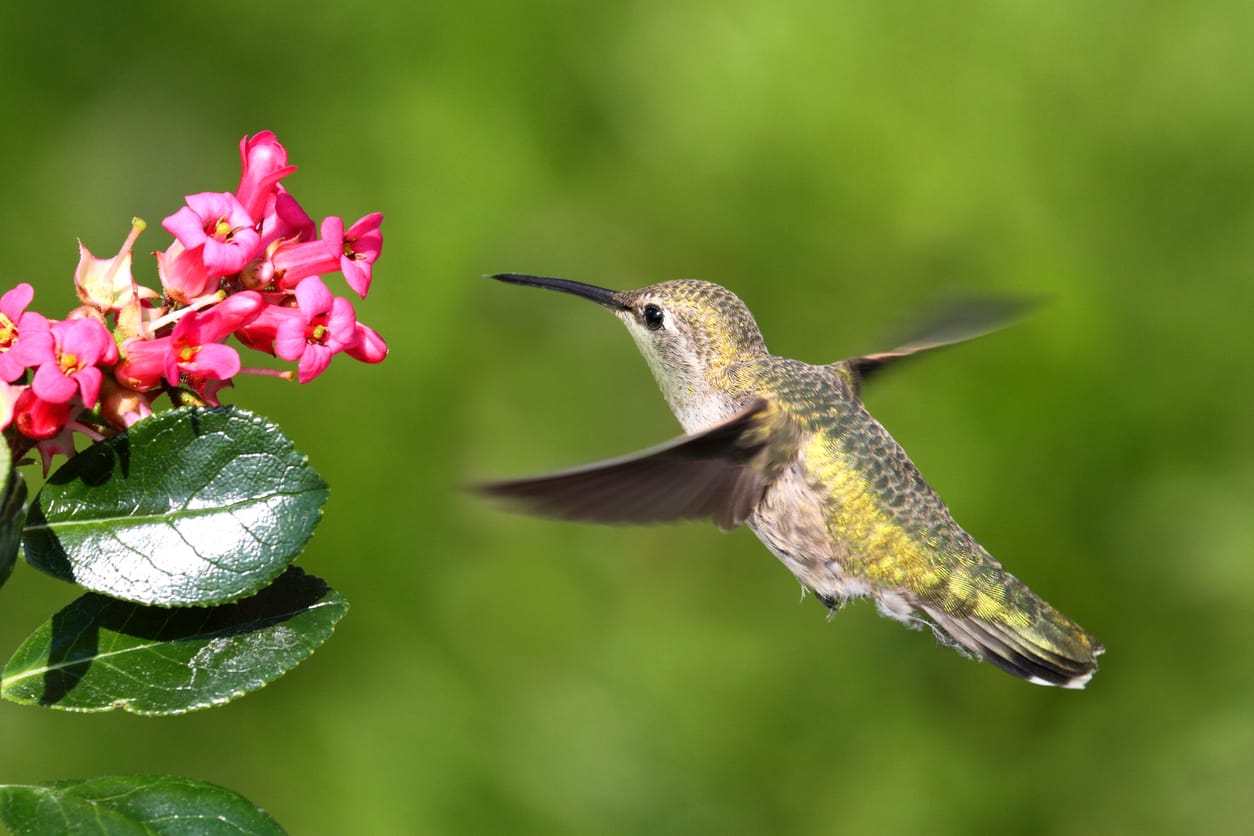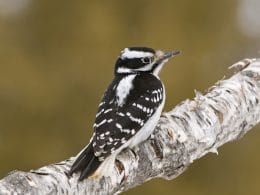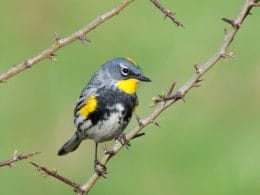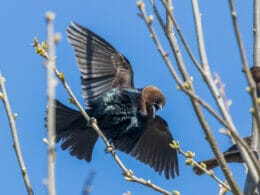The hummingbird is a small bird that feeds on nectar. These birds are brightly colored—most of them, at least—and have distinct appearances.
With over 330 species and 115 genera, the hummingbird family is vast. About 15 different types of hummingbirds are primarily found in the United States.
This number, however, isn’t set in stone, as different species frequently roam and wander from neighboring countries.
If you’re a bird watcher in Missouri, you can definitely find beautiful hummingbirds flying around. That being said, we’ve compiled a list of 8 hummingbirds in Missouri that you can find.
8 Most Common Hummingbirds in Missouri
1. Ruby-Throated Hummingbird
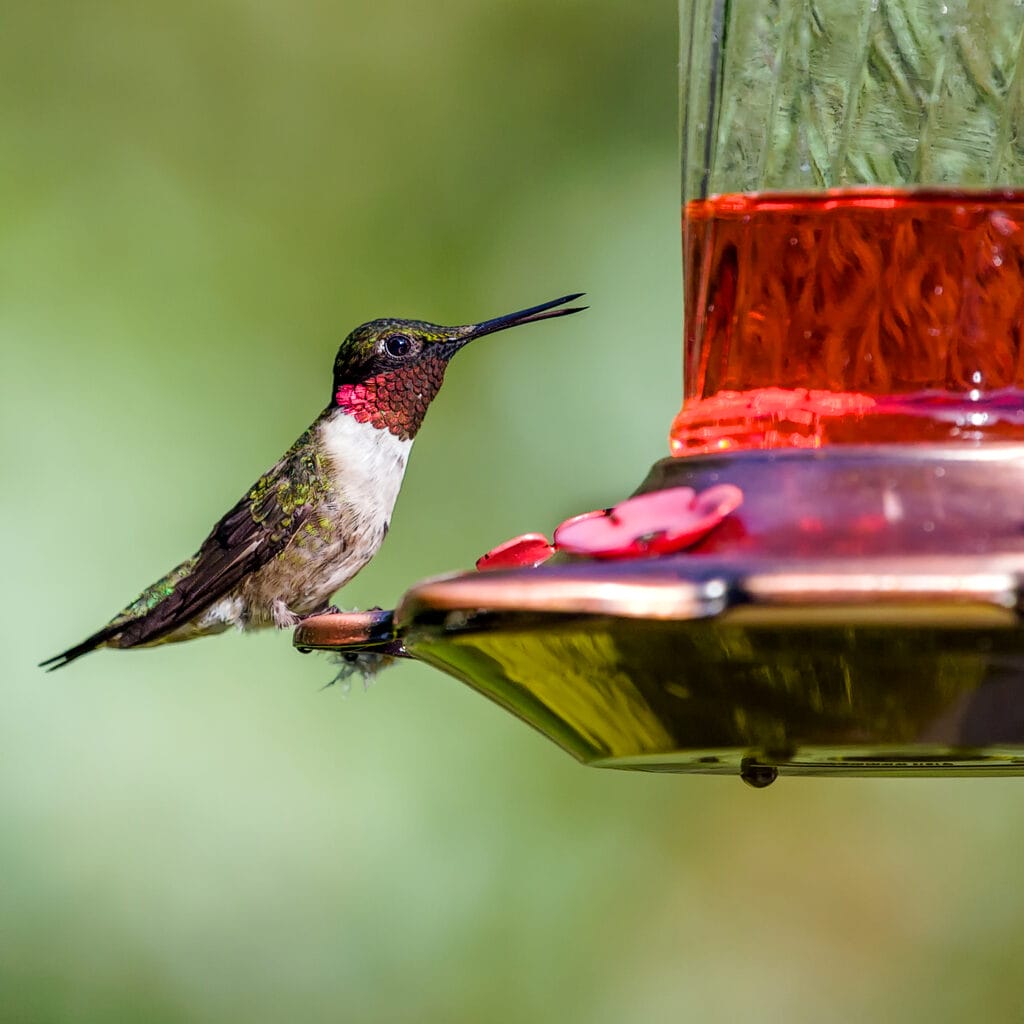
- Scientific name: Archilochus Colubris
- Length: 2.9-3.5 inches
- Weight: 0.10 ounces
- Wingspan: 4 inches
If you see a hummingbird with an exotic red neck, you’re probably seeing a Ruby-throated Hummingbird. They’re small hummingbirds with emerald green backs and crowns. Females and young birds have white necks, while males have red necks. They’re the most common species of hummingbirds in Missouri.
The hummingbird’s wings are short. Despite their small wings, hummingbirds can flap their wings at a rate of 53 times per second.
The birds’ legs are also small, preventing them from walking or skipping. The bird, on the other hand, can shuffle across a ledge.
Because these birds are so little, they can easily exhaust themselves. Their hearts can beat at 600-1,200 beats per minute on average, depending on how much effort the bird is doing. In comparison, the human heart beats at a pace of 100-170 beats per minute while running.
Author Note: Like all hummingbirds, the Red-Throated Hummingbird likes to feed on nectar from flowers. The amount of nectar they have to consume should amount to at least half their body weight.
As with most other hummingbirds, the Ruby-throated Hummingbird has a long tongue. Their tongues are typically coiled up around their skull and eyes when they retract it. It’s also incredibly thin and forked to make it easier for the birds to consume the nectar.
Because of the shape of their tongue, these birds prefer tubular-shaped flowers. Also, they tend to be attracted to orange and red flowers. That is because red and orange flowers are often rich in nectar.
Nectar isn’t the only sustenance these birds can eat. They rely also on small arthropods and insects are their primary source of protein. Hummingbirds require protein, especially while nursing their youngsters. The protein helps in the healthy growth of the muscles and feathers.
Forests, parks, and gardens are ideal habitats for the Ruby-throated Hummingbirds. The majority of hummingbirds, including the Ruby-throated, prefer warmer weather, so you can find them throughout the summer in Missouri. They can be found near nectar feeders outside of homes and in open places like gardens.
2. Rufous Hummingbird
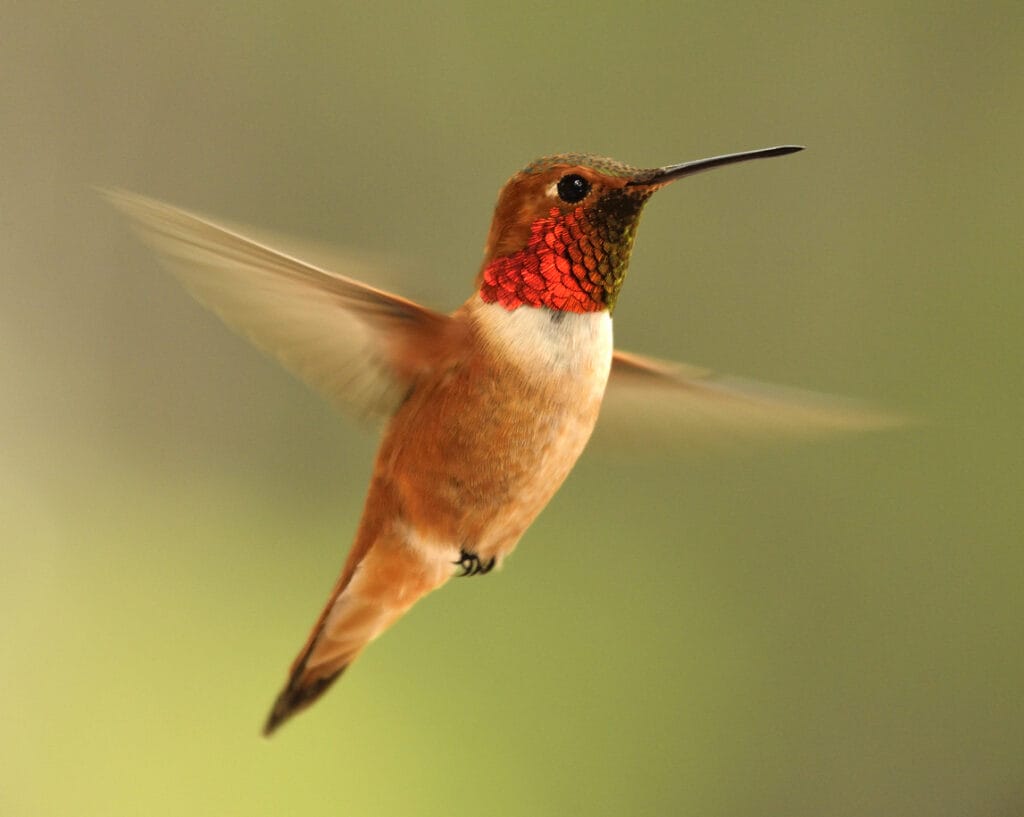
- Scientific name: Selasphorus Rufus
- Length: 3.5-4 inches
- Weight: 0.12 ounces
- Wingspan: 4.25 inches
The Rufous Hummingbird is a small-sized hummingbird recognized for its exceptional flight abilities. Despite their small size, they’re capable of defeating larger birds if necessary.
The males have a stunning orange body, while the females’ bodies are a mix of emerald and orange.
Due to their excellent flying abilities, they can fly great distances. Also, these birds have one of the greatest migration treks of any bird in the world. During their migration crossings, they can travel up to 2,000 miles and even beyond at times.
Hummingbirds can float in position by quickly flapping their wings. To be specific, the Rufous Hummingbird can flap its wings at a rate of 52 to 62 beats per second.
The Rufous Hummingbird is recognized for its incredible memory. They can make note of which flowers they already feed from so they can go to others. Not only that, but they can recall the placement of old bird feeders that have been uninstalled from their place.
Author Note: Rufous Hummingbirds are thought to be the most hostile of the hummingbird family. These birds are regularly seen attacking other birds away from feeding and breeding places.
These hummingbirds flutter and spread their tails when they are disturbed. That is usually an indication that the bird will attack.
The Rufous, like other hummingbirds, feeds on nectar and insects. The insects are usually taken from spider webs or caught in mid-flight by the birds.
Rufous Hummingbirds prefer open spaces like woodlands. As long as they have sufficient sustenance, you can spot them living alongside people in the cities. Usually, they’re found in parks and yards.
3. Calliope Hummingbird

- Scientific name: Selasphorus Calliope
- Length: 2.8-3.9 inches
- Weight: 0.071 to 0.106 ounces
- Wingspan: 4.3 inches
If the name sounds familiar, it’s because the bird is named after Calliope, who was the Greek mythological muse of speech and poetry.
The Calliope Hummingbird is considered to be the smallest bird that lives in the US. Despite their small size, these birds may turn territorial and attack birds as large as hawks. They usually tend to be more hostile during mating season.
These hummingbirds have short tails and wings that hardly reach past the edge of the tail. The bodies of both sexes are green.
The males, on the other hand, stand out more due to the pink streaks on their necks. The underparts of females and young birds have a light pink tint.
The Calliope Hummingbird is said to be the world’s smallest long-distance traveler. Annually, they travel between 5,000 and 6,000 miles. These birds fly at an average pace of 18.6 miles per hour.
Calliope Hummingbirds feed on nectar from flowering plants. Additionally, they catch small insects in the air or from spider webs.
The birds prefer to nest in open woodlands and highland meadows. During the winter, however, they prefer to spend their time in Mexico’s pine-oak woods.
4. Allen’s Hummingbird

- Scientific name: Selasphorus Sasin
- Length: 3-3.5 inches
- Weight: 0.10 ounces
- Wingspan: 4.3 inches
Allen’s Hummingbird was named after Charles Andrew Allen, who was a taxidermist. After the Calliope, Allen’s Hummingbird is regarded as the smallest hummingbird.
The birds are mostly orange and green in color. Females and juveniles are bronze-green in hue, while males are coppery.
Their appearance is similar to that of the Rufous Hummingbird. Allen’s Hummingbird has a reddish tail and an emerald back and rump, whereas the Rufous’ entire body is generally reddish-orange.
Allen’s Hummingbirds regulate their core temperature with their feet. When it’s hot, they’ll let their legs hang while flying to keep them cool. When the weather is cold, they curl their feet up while flying towards their stomachs for warmth.
Author Note: An interesting fact is that both sexes tend to stay in different habitats during the breeding season. The male establishes a domain that includes open stretches of coastal vegetation.
During mating season, the female goes to these regions to look for males. The female bird, on the other hand, travels into the forest after mating to make a nest and care for her offspring.
5. Black-Chinned Hummingbird
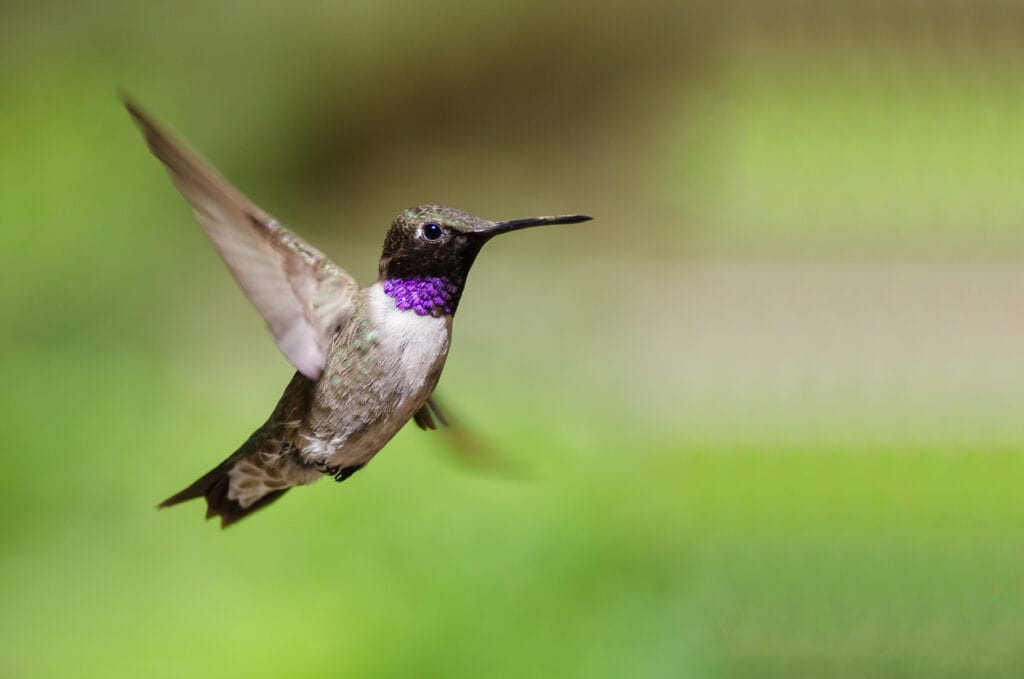
- Scientific name: Archilochus Alexandri
- Length: 3.25 inches
- Weight: 0.10 ounces
- Wingspan: 4.3 inches
The Black-chinned Hummingbird is one of the most common hummingbirds in the world. They can be found in many different locations, including forests, mountains, and deserts.
The birds’ bodies are usually metallic green. Males have dark split tails and a black head. The females have a distinct look from the males; their tails are rounded and have white ends.
Young Black-chinned Hummingbirds are born nearly without feathers. Around three weeks of birth, the young birds develop a full set of feathers. Purple feathers on their throats are common within the juveniles.
Hummingbirds use plants and silk to construct their nest. Their eggs are around the size of a bean, hence their nests tend to be small. The nest appears to adapt and enlarge as the youngsters grow.
Nectar and insects are the main sources of food for Black-chinned Hummingbirds. They prey on little insects as well as take nectar from flowers. Hummingbird feeders with sugar-water combinations may also attract them.
6. Anna’s Hummingbird

- Scientific name: Calypte Anna
- Length: 4 inches
- Weight: 0.1-0.2 ounces
- Wingspan: 4.7 inches
Anna Masséna, the Duchess of Rivoli, was the muse for naming Anna’s Hummingbird. The bird originated along the western coasts of North America. The stunning birds have a distinct look to them.
Their appearances feature a grayish-white underbelly and a glossy green back. The bird’s head and throat feathers are rosy-red and reach to the sides of the neck.
The females have a distinct appearance from the males. They have green heads with a slight amount of crimson color on their throats.
Anna’s Hummingbirds eat insects as well as nectar from flowers. Each day, the bird can eat up to half of its body weight in nectar. When it comes to insects, Anna’s Hummingbirds feed on insects more than any other hummingbird in North America.
Top Tip: In comparison to humans, the bird has a burning body temperature. These birds’ usual temperature is 107 degrees Fahrenheit.
When the weather turns chilly, birds become dormant and enter a state known as torpor. Their breathing and heart rate both slow down in this state. Not only that, but until the weather warms up again, their body temperature will decrease.
The bird will be energetic again once the weather has warmed up.
7. Mexican Violetear

- Scientific name: Colibri Thalassinus
- Length: 3.8-4.7 inches
- Weight: 0.20 ounces
- Wingspan: 4.72 inches
Mexico and Central America are home to the Mexican Violetear. They have been known to live as far north as Canada.
These species are classified as medium-sized birds. Their backs and bellies are usually green. They also have purplish ears and dark blue tails with broad black color.
The Mexican Violetear likes to be alone. They can, however, be found in small groups where there is enough food availability.
They eat a lot of nectar as part of their diet. Insects can also make up a significant amount of their nutrition. If you want to attract them to your yard, hummingbird feeders are your go-to.
The Mexican Violetear’s nest is frequently built on a branch, close to the surface. The female is the only builder of the nest. Also, they incubate the eggs and take care of the juveniles alone. The nest is constructed of plant down, twigs, and moss.
8. Broad-Tailed Hummingbirds

- Scientific name: Selasphorus Platycercus
- Length: 3.26-3.81 inches
- Weight: 0.12 ounces
- Wingspan: 5.25 inches
The Broad-tailed Hummingbird is one of the most stunning hummingbirds in the world. In comparison to other North American hummingbirds, they have lengthy bodies.
These hummingbirds can be found in the United States, Canada, Mexico, and Guatemala. They favor wide woodland regions with pine and oak trees as well as flowering shrubs.
The green and vibrant red coloration of the Broad-tailed Hummingbird makes it easy to identify. Their bodies are green, and their chests are white. The males have a crimson gorget, while the females and the young ones have green patches on their necks.
Top Tip: Numerous characteristics distinguish this bird from the rest. In comparison to other types of birds, these hummingbirds have the unique capability of flying backward.
The hummingbirds make a lot of noise as well. The chirping may be heard 50 miles away by the male birds. Females, on the other hand, have greater hearing and can detect the tweeting from a distance of 75 miles.
The birds like to eat floral nectar, small insects, and tree sap left by woodpeckers. The Broad-tailed Hummingbird prefers to float above flowers to drink the nectar as well as catch insects in the air.
Wrapping Up
If you’re a dedicated bird watcher in Missouri, you’ll certainly encounter a few lovely species of hummingbirds. In Missouri, there are eight different types of hummingbirds. With their various appearances, they’re all wonderfully colored.
If you’d like to attract them to your backyard, it’s an easy and doable process. You only need to hang a hummingbird feeder. You’ll have a flock of stunning birds in your yard before you realize it.
If you spot those beautiful birds, take a picture and let us know which one is your favorite. Thanks for checking out our guide on hummingbirds in Missouri!
FAQ
The best place to try is any public garden, botanical garden or your own backyard! Put a hummingbird feeder up in your garden and see what comes!
The Ruby-throated Hummingbird is the most commonly seen species in Missouri.
To find out where recent sightings of hummingbirds have been, try eBird. You can search for the latest sightings or particular species or what has been seen in a certain area.




